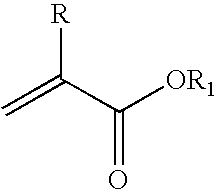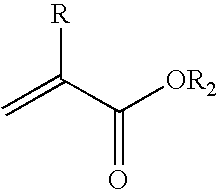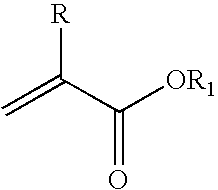Method for the synthesis of (meth)acrylic esters catalysed by a polyol titanate
- Summary
- Abstract
- Description
- Claims
- Application Information
AI Technical Summary
Benefits of technology
Problems solved by technology
Method used
Image
Examples
example 1
Preparation of a TIPOL1 Catalyst
[0060]The following are charged to a stirred reactor heated by circulation of a thermostatically controlled oil in a jacket and surmounted by a multiknit-packed distillation column with top glycol-water condenser, reflux ratio head, vacuum distillation receiver, and collecting vessels and traps:[0061]200 g of a mixture constituted of 80% of tetraethyl titanate and 20% of tetraisopropyl titanate (sold under the name Vertec AC 560 by Johnson Matthey)[0062]24.8 g of ethylene glycol[0063]300 g of cyclohexane.
[0064]The reaction mixture is refluxed at atmospheric pressure for 3 h. The light alcohols, ethanol and isopropanol, released during the ligand exchange, are eliminated by distillation in the form of azeotropes with the cyclohexane.
[0065]The residual cyclohexane is then distilled. In the end, 195 g of crude product, which is in the form of a slightly viscous orange liquid (TIPOL1), are obtained.
example 2
Synthesis of dimethylaminoethyl acrylate (DMAEA)
[0066]The following are charged to the reactor described in example 1:[0067]595 g of methyl acrylate (MA)[0068]173.5 g of N,N-dimethylaminoethanol[0069]1.5 g (2000 ppm relative to the charge) of phenothiazine[0070]0.75 g (1000 ppm relative to the charge) of BHT (di-tert-butyl-para-cresol).
[0071]Throughout the entire synthesis, air is bubbled into the reaction mixture.
[0072]The water present in the charge, originating from the alcohol, is eliminated by distillation at atmospheric pressure, in the form of an MA / water azeotrope.
[0073]After the above drying phase, a further amount of methyl acrylate, corresponding to the mass of the drying fraction, is introduced. 6.85 g (0.008 mol) of TIPOL1 are subsequently introduced.
[0074]The reaction is carried out at atmospheric pressure with a temperature in the reaction medium of between 85 and 95° C. The methanol formed during the reaction is eliminated as it forms, in the form of an MA / methanol a...
example 5
[0080]Two polyol titanates, called TIPOL2 and TIPOL3, are prepared under the conditions of example 1 using isopropyl titanate and, respectively, ethylene glycol and propylene glycol with an isopropyl titanate / diol molar ratio=2 / 1.
[0081]These two polyol titanates are subsequently used as catalysts for the synthesis of DMAEA according to the protocol used in example 2.
[0082]The crude reaction products obtained with these catalysts are completely liquid and clear.
[0083]The conversion rate and selectivity are identical with TIPOL2 or TIPOL3, and are 98% and 96%, respectively.
PUM
| Property | Measurement | Unit |
|---|---|---|
| Fraction | aaaaa | aaaaa |
| Dimensionless property | aaaaa | aaaaa |
Abstract
Description
Claims
Application Information
 Login to View More
Login to View More - R&D
- Intellectual Property
- Life Sciences
- Materials
- Tech Scout
- Unparalleled Data Quality
- Higher Quality Content
- 60% Fewer Hallucinations
Browse by: Latest US Patents, China's latest patents, Technical Efficacy Thesaurus, Application Domain, Technology Topic, Popular Technical Reports.
© 2025 PatSnap. All rights reserved.Legal|Privacy policy|Modern Slavery Act Transparency Statement|Sitemap|About US| Contact US: help@patsnap.com



